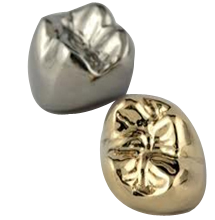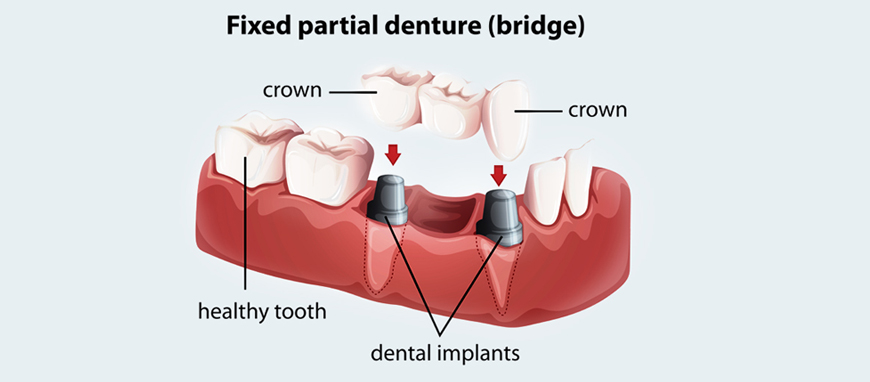
Crowns And Bridges
Both crowns and bridges, in most cases, are fixed prosthetic devices. Unlike removable devices such as dentures, which you can take out and clean daily, crowns and bridges are cemented onto existing teeth or implants, and can only be removed by a dentist.
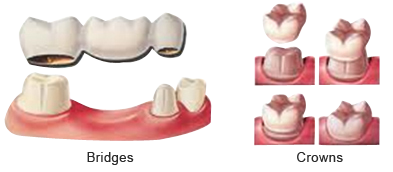
How do Crowns Work?
A crown is used to entirely cover or "cap" a damaged tooth. Besides strengthening a damaged tooth, a crown can be used to improve its appearance, shape or alignment. A crown can also be placed on top of an implant to provide a tooth-like shape and structure for function.
Your dentist may recommend a crown to:
- Replace a large filling when there isn't enough tooth remaining
- Restore a fractured tooth
- Cover a dental implant
- Cover a tooth that has had root canal treatment
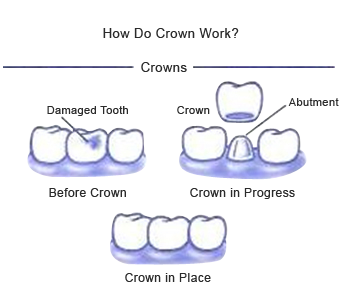
How do Bridges Work?
A bridge may be recommended if you're missing one or more teeth. Gaps left by missing teeth eventually cause the remaining teeth to rotate or shift into the empty spaces causing malocclusion.
Bridges are commonly used to replace one or more missing teeth. They span the space where the teeth are missing. Bridges are cemented to the natural teeth or implants surrounding the empty space. These teeth, called abutments, serve as anchors for the bridge. A replacement tooth, called a pontic, is attached to the crowns that cover the abutments.
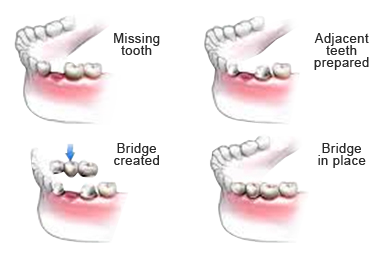
How are Crowns and Bridges Made?
Before either a crown or a bridge can be made, the tooth (or teeth) must be reduced in size so that the crown or bridge will fit over it properly. After reducing the tooth/teeth, your dentist will take an impression to provide an exact mold for the crown or bridge. If porcelain is to be used, your dentist will determine the correct shade for the crown or bridge to match the color of your existing teeth.
How Long do Crowns and Bridges Last?
While crowns and bridges can last a lifetime, they do sometimes come loose or fall out. The most important step you can take to ensure the longevity of your crown or bridge is to practice good oral hygiene. A bridge can lose its support if the teeth or bone holding it in place are damaged by dental disease. Keep your gums and teeth healthy by Brushing with fluoride toothpaste twice a day and flossing daily. Also see your dentist regularly for checkups and professional cleanings.
To prevent damage to your new crown or bridge, avoid chewing hard foods, ice or other hard objects.
Different Types Of Crowns And Bridges:
- Vitallium Crowns and Bridges (Full metal)
- Porcelain Fused to Metal
- Ceramic
- Ceramic Free / Zirconia Crowns
- Precious Metal (Gold)
Base metal alloys contain non-noble metals which provide great strength to the crown and tooth and provide high resistance to corrosion. When preparing the tooth using base metal alloys, the dentist or prosthodontist would remove the least amount of healthy tooth structure. This material is resistant to wear and gentle to opposing teeth.
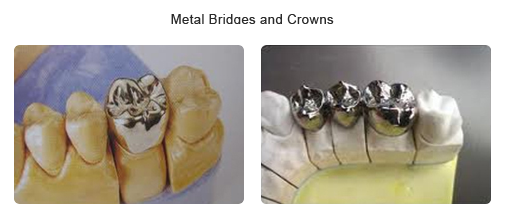
Porcelain fused to metal is connected to the outside of a metal structure to provide strength to the teeth as well as provide a good seal to prevent leakage and decrease recurrent dental decay. When porcelain is fused to metal, it provides a stronger restoration than porcelain alone. The dentist or prosthodontist will remove a moderate amount of tooth structure, but it is very durable and strong.
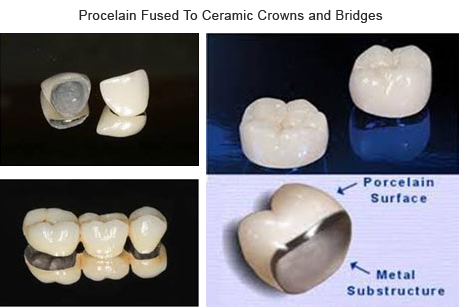
All ceramic crowns are a porcelain-based filling material and recommended for restoring front teeth due to color blending with the natural teeth. The dentist or prosthodontist may need to remove more tooth structure to attach the porcelain to the tooth; however, the material may be brittle under heavy biting and can be highly resistant to wear.

Gold alloys are comprised of gold, copper and other metals and provide a strong material to adhere to the tooth structure. Gold alloy is resistant to wear and fracture and does not wear away the teeth it comes in contact with. This material is highly biocompatible with the gum tissue.
